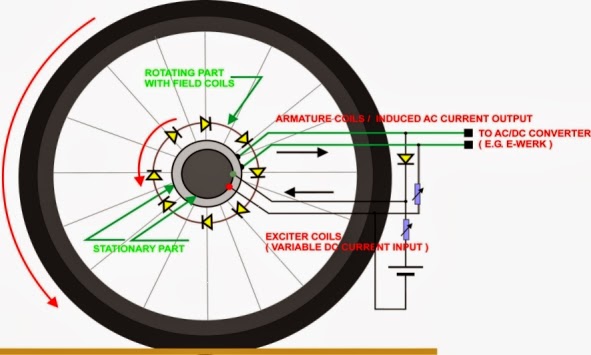ConRAD wrote: … why not a 3 to 9W variable power generator?
I think what you’re asking is why not have a dynamo that will drive any lamp between 3W and 9W. The short answer is because of the simple method a bike dynamo uses to keep the output relatively constant as the speed of the bike varies. For a longer answer we need to start from square one.
When you move a conductor through a magnetic field it generates a voltage which is proportional to the velocity, so the output voltage of any generator is proportional to the speed at which it rotates (as is the frequency). If the generator is going in somewhere like a power station where the turbines turn at a constant speed that’s not a problem, but the speed of a bike varies by 10:1 or even more, so that leaves you with a corresponding variation in supply voltage unless you do something about it. What the manufacturer is looking for is a cheap and simple way of keeping the output to a lamp constant, or near enough constant to prevent the filament blowing.
The way it’s done is using an inductive source impedance. The reactance of an inductor is proportional to the frequency; so as the frequency is proportional to the speed, you will have a source impedance which is nearly proportional to the speed once you’re going fast enough for the reactance to be significantly larger than the sum of the source and load resistances. Current is voltage divided by impedance, so since the voltage and the impedance are both proportional to speed you end up with a current which remains independent of speed.
At this point we need a little digression to understand the difference between constant current and constant voltage sources. When electronics engineers use these two terms, unless explicitly stated otherwise the word constant refers to variations with respect to load resistance and not speed or any other parameter. As we’ve seen, we’ve ended up with a supply which has a voltage and current which are both fairly constant with respect to speed, but this is a constant current supply, because it is the current and not the voltage which remains the same as the load changes.
A generator approximates a constant current when the load is much lower than the source impedance because total circuit impedance is relatively independent of load changes and thus current is relatively constant. However if the load impedance is much higher than the source, the voltage lost across the source impedance is only a small fraction of the total, and so you now have a constant voltage source. In our case, the manufacturers have designed the source impedance to be much higher than the load, so we have a constant current generator and not a constant voltage. The load voltage is only constant so long as the load resistance remains constant.
Fine so far, but power is both V^2/R and I^2R. Bulbs are designed to run off a constant voltage supply, not constant current, so the resistance of a 9W bulb will be a third of that of a 3W bulb that runs off the same voltage. If you now connect it to a supply that delivers a constant current that’s correct for the 3W bulb you will end up with a 9W bulb that’s only actually dissipating 1W. Alternatively, a 1W bulb would have the right resistance to produce 9W, but it will promptly blow because it’s dissipating nine times its rated power. An 18V 9W bulb would have the correct resistance, but then you will have to cycle about three times faster before the output of your dynamo stabilises enough to give you a relatively constant brightness.
So, the reason that the same dynamo can’t run different size bulbs is that the source impedance has to be tailored to a specific bulb size so as to take advantage of a cheap and simple way of regulating the output. Whatever the size of the dynamo you still come back to the same problem of obtaining a constant output. A generator with a low impedance output and a solid state regulator will keep the voltage stable as the speed varies, but how many are going to pay for it? Something like the B&M E-Werk costs around ten times the price of a cheap dynamo, so it looks as if they’re having trouble finding enough demand to get the economies of scale.

